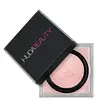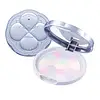Huda Beauty Easy Bake Loose Baking & Setting Powder Versus Canmake Illuminating Finish Powder Abloom
What's inside
What's inside
 Key Ingredients
Key Ingredients

 Benefits
Benefits

No benefits
 Concerns
Concerns

 Ingredients Side-by-side
Ingredients Side-by-side

Talc
AbrasiveSynthetic Fluorphlogopite
Silica
AbrasiveDimethicone
EmollientNylon-12
Caprylyl Glycol
EmollientPentylene Glycol
Skin ConditioningOryza Sativa Starch
AbsorbentPhenyl Trimethicone
Skin ConditioningSodium Dehydroacetate
PreservativeOctyldodecyl Stearoyl Stearate
EmollientDiisostearyl Malate
EmollientParfum
MaskingTocopheryl Acetate
AntioxidantBenzyl Salicylate
PerfumingSorbitan Sesquioleate
EmulsifyingHexyl Cinnamal
PerfumingLinalool
PerfumingCoumarin
PerfumingHydroxycitronellal
PerfumingBenzyl Benzoate
AntimicrobialIron Oxides
Ultramarines
CI 19140
Cosmetic ColorantCI 77499
Cosmetic ColorantCI 73360
Cosmetic ColorantTalc, Synthetic Fluorphlogopite, Silica, Dimethicone, Nylon-12, Caprylyl Glycol, Pentylene Glycol, Oryza Sativa Starch, Phenyl Trimethicone, Sodium Dehydroacetate, Octyldodecyl Stearoyl Stearate, Diisostearyl Malate, Parfum, Tocopheryl Acetate, Benzyl Salicylate, Sorbitan Sesquioleate, Hexyl Cinnamal, Linalool, Coumarin, Hydroxycitronellal, Benzyl Benzoate, Iron Oxides, Ultramarines, CI 19140, CI 77499, CI 73360
Talc
AbrasiveMethoxycyclododecane
PerfumingVinyl Dimethicone/Methicone Silsesquioxane Crosspolymer
Diisostearyl Malate
EmollientSilica
AbrasiveZinc Laurate
Squalane
EmollientTriethylhexanoin
MaskingButylene Glycol
HumectantBHT
AntioxidantArgania Spinosa Kernel Oil
EmollientArnica Montana Flower Extract
MaskingChamomilla Recutita Flower Extract
MaskingDimethicone
EmollientEquisetum Arvense Extract
AstringentHedera Helix Leaf/Stem Extract
AntimicrobialQuercus Robur Bark Extract
AstringentRosa Centifolia Flower Extract
AstringentCamellia Sinensis Leaf Extract
AntimicrobialTocopherol
AntioxidantPerfluorooctylethyl Triethoxysilane
Hamamelis Virginiana Leaf Extract
Skin ConditioningSodium Hyaluronate
HumectantButylparaben
MaskingVitis Vinifera Leaf Extract
Skin ConditioningDipentaerythrityl Hexahydroxystearate
EmulsifyingSimmondsia Chinensis Seed Oil
EmollientMica
Cosmetic ColorantMethylparaben
PreservativeSaxifraga Sarmentosa Extract
Skin ConditioningWater
Skin ConditioningSoluble Collagen
HumectantSynthetic Fluorphlogopite
Tin Oxide
AbrasiveTitanium Dioxide
Cosmetic ColorantIron Oxides
CI 45380
Cosmetic ColorantCI 77120
Cosmetic ColorantTalc, Methoxycyclododecane, Vinyl Dimethicone/Methicone Silsesquioxane Crosspolymer, Diisostearyl Malate, Silica, Zinc Laurate, Squalane, Triethylhexanoin, Butylene Glycol, BHT, Argania Spinosa Kernel Oil, Arnica Montana Flower Extract, Chamomilla Recutita Flower Extract, Dimethicone, Equisetum Arvense Extract, Hedera Helix Leaf/Stem Extract, Quercus Robur Bark Extract, Rosa Centifolia Flower Extract, Camellia Sinensis Leaf Extract, Tocopherol, Perfluorooctylethyl Triethoxysilane, Hamamelis Virginiana Leaf Extract, Sodium Hyaluronate, Butylparaben, Vitis Vinifera Leaf Extract, Dipentaerythrityl Hexahydroxystearate, Simmondsia Chinensis Seed Oil, Mica, Methylparaben, Saxifraga Sarmentosa Extract, Water, Soluble Collagen, Synthetic Fluorphlogopite, Tin Oxide, Titanium Dioxide, Iron Oxides, CI 45380, CI 77120
 Reviews
Reviews

Ingredients Explained
These ingredients are found in both products.
Ingredients higher up in an ingredient list are typically present in a larger amount.
Diisostearyl Malate is an emollient and most often used in lip products. It comes from isostearyl alcohol, a fatty acid, and malic acid, an AHA.
As an emollient, Diisostearyl Malate helps create a thin film on your skin to trap moisture in. This helps keep your skin soft and smooth.
Dimethicone is a type of synthetic silicone created from natural materials such as quartz.
What it does:
Dimethicone comes in different viscosities:
Depending on the viscosity, dimethicone has different properties.
Ingredients lists don't always show which type is used, so we recommend reaching out to the brand if you have questions about the viscosity.
This ingredient is unlikely to cause irritation because it does not get absorbed into skin. However, people with silicone allergies should be careful about using this ingredient.
Note: Dimethicone may contribute to pilling. This is because it is not oil or water soluble, so pilling may occur when layered with products. When mixed with heavy oils in a formula, the outcome is also quite greasy.
Learn more about DimethiconeSilica, also known as silicon dioxide, is a naturally occurring mineral. It is used as a fine, spherical, and porous powder in cosmetics.
Though it has exfoliant properties, the function of silica varies depending on the product.
The unique structure of silica enhances the spreadability and adds smoothness, making it a great texture enhancer.
It is also used as an active carrier, emulsifier, and mattifier due to its ability to absorb excess oil.
In some products, tiny microneedles called spicules are made from silica or hydrolyzed sponge. When you rub them in, they lightly polish away dead skin layers and enhance the penetration of active ingredients.
Learn more about SilicaSynthetic Fluorphlogopite is the synthethic version of mica. It consists of fluorine, aluminum and silicate.
Synthetic Fluorphlogopite is used to add volume to products.
It is considered non-irritating on the skin.
Learn more about Synthetic FluorphlogopiteTalc is a clay mineral. It helps absorb moisture and improve the texture of products. Like other types of clay, Talc can have a slight exfoliating effect on skin. Talc can be added to increase the volume of products.
Some Baby powders are made by combining talc with corn starch. The word "talc" comes from Latin and originates from Arabic. Talc is a mineral commonly found throughout the world.
If you have any concerns about using talc, we recommend checking out the FDA's official page.
Learn more about TalcThis ingredient is a combination of red, black, and yellow iron oxide pigments. This combination of colors is usually found in foundation, because it results in a "skin" color.